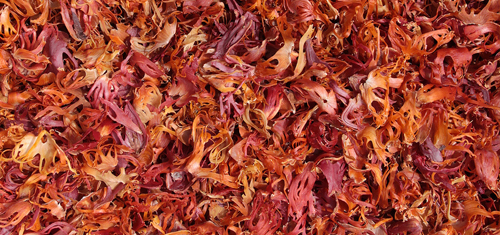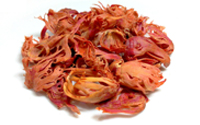Mace
Mace
Pronounced: m-AI-s

Mace spice is a dried, outer aril, enveloping firmly around the nutmeg kernel. Nutmeg kernel and mace arils indeed are two separate spice products of same nutmeg fruit. However, mace characteristically compose higher concentration of certain essential oils and features refined yet intense aroma than nutmeg. For the same reasons, it commands higher price.
What Is Mace?
 Mace is the aril (the bright red, lacy covering) of the nutmeg kernel shell. It’s removed and dried separately from nutmeg, and you can find it sold as whole “blades” or ground into a powder. In flavor, mace is very similar to nutmeg, though more subtle and delicate. The yield of mace is much less than nutmeg’s that is why Mace has a greater value.
Mace is the aril (the bright red, lacy covering) of the nutmeg kernel shell. It’s removed and dried separately from nutmeg, and you can find it sold as whole “blades” or ground into a powder. In flavor, mace is very similar to nutmeg, though more subtle and delicate. The yield of mace is much less than nutmeg’s that is why Mace has a greater value.
Plant and Cultivation
Once harvested from the tree, its outer pulp or husk is removed and discarded. Just underneath the tough husk is the golden-brown color aril, known as “mace,” enveloping firmly around the nutmeg kernel. Mace is gently peeled off from the kernel surface, flattened into strips, dried, and sold either as whole “mace blades” or finely ground into powder. The nutmeg kernels are then dried under sun for several days to weeks. At larger commercial set-ups, this process is carried out rather more quickly over a hot drier machine until the whole nutmeg rattles inside the shell.
Description
In its natural state, mace is a bright crimson lace up to 35 mm (1-1/2 in) long, encasing the brown nutmeg in irregular, fleshy lobes. As it is dried, it develops its charcteristic aroma but loses its bright red colour. Mace from the West Indies is a yellowish brown colour and with fewer holes than mace from East Indian nutmegs which are more orange when dried. The mace from either locale can become brittle and horny, though the best quality mace will retain some pliability and release a little oil when squeezed. It is flattened and sometimes roughly broken into ‘blades’. It is also sold ground and sometimes still enclosing the nutmeg.
Producing Countries of Mace
Naturally, nutmeg is limited to the Banda Islands, a tiny archi¬pelago in Eastern Indonesia (Moluccas). Main producing countries today are Indonesia (East Indian Nutmeg) and Grenada (West Indian Nutmeg). World production of nutmeg is estimated to average between 10,000 and 12,000 tonnes per year, with annual world demand estimated at 9,000 tonnes; production of mace is estimated at 1,500 to 2,000 tonnes. Indonesia and Grenada dominate production and exports of both products, with world market shares of 75% and 20%, respectively. Other producers include India, Malaysia, Papua New Guinea, Sri Lanka, and Caribbean islands, such as St. Vincent.
Consuming Countries of Mace
Nutmegs are mainly exported to Europe and Asia, Grenada nutmeg mostly finds its way into the USA. The principal import markets are the European Community, the United States, Japan, and India. Singapore and the Netherlands are major re-exporters.
Grades of Mace
Standard Whole Mace
| SPECIFICATION | SUGGESTED LIMITS |
|---|---|
| ASTA CLEANLINESS SPECIFICATION | |
| Whole Dead Insects, by Count | 4 |
| Mammalian excreta, by mg / lb | 3 |
| Other excreta, by mg / lb | 1 |
| Mold.% by Weight | 2 % |
| Insect Defiled / Infested, % by Weight | 1 % |
| Extraneous,% by Weight | 0.5 % |
| FDA DAL'S | |
| Insect Infested Pieces by Weight | Ave. of 3% |
| Mammalian Excreta | Ave. of 3 mg/ lb |
| Foreign Matter | Ave. of 1.5% |
| Volitle Oil" | 15.0% min |
| Moisture" | 8.0% max |
| Ash" | 5.0% max |
| Acid Insoluble ash" | 0.5% max |
| Average bulk Index (mg /100 g ) | N/A |
